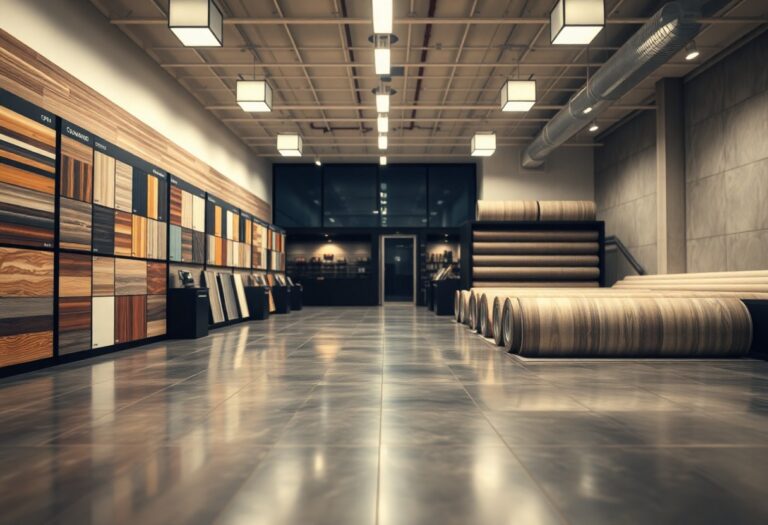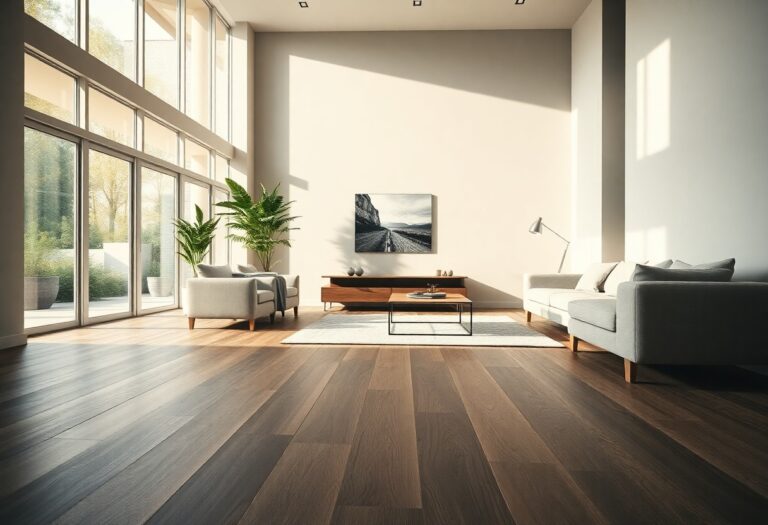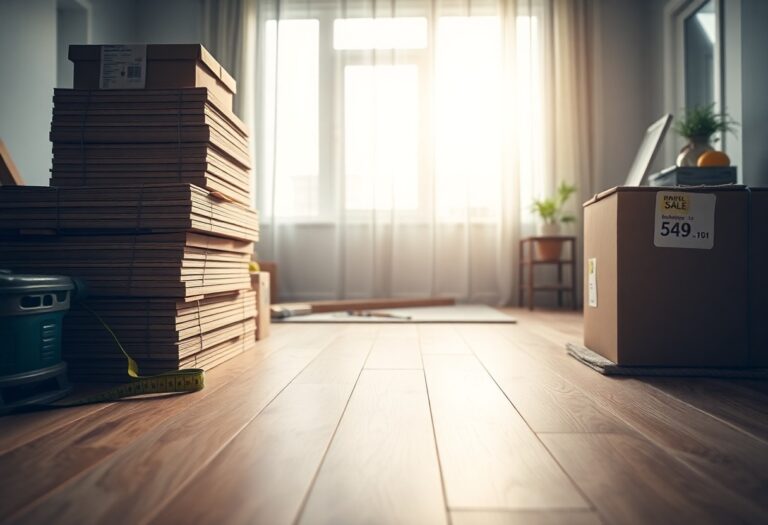Most homeowners face the dilemma of choosing the right flooring option that combines durability and style. As far as waterproof laminate and engineered flooring, understanding the differences and advantages of each can significantly impact your living space. Both options offer unique benefits that cater to varying needs and preferences, so assessing your lifestyle, aesthetic goals, and budget will help you make an informed decision for your home.

Overview of Waterproof Laminate Flooring
Waterproof laminate flooring combines the aesthetic appeal of traditional laminate with enhanced durability against moisture. Ideal for high-traffic areas and rooms prone to spills, such as kitchens and bathrooms, this flooring option features a tightly sealed surface that prevents water infiltration while maintaining a natural wood look. Innovations in manufacturing have led to improved performance, making it a popular choice for homeowners seeking both beauty and resilience.
Definition and Features
Waterproof laminate flooring is specifically designed to resist water damage, consisting of multiple layers, including a moisture-resistant core and a protective overlay. This flooring typically mimics the appearance of hardwood or stone, offering various styles and finishes. Many options come with an easy-click installation system, allowing for straightforward DIY projects while ensuring a seamless, attractive floor.
Pros and Cons
Pros and Cons
| Pros | Cons |
|---|---|
| Highly resistant to water damage | Can be less durable than hardwood |
| Easy and quick installation | May not add as much value as hardwood |
| Variety of styles available | Less eco-friendly options available |
| Stain and scratch resistant | Sound can be less appealing underfoot |
| Low maintenance | Limited repairs possible |
| Affordably priced compared to real wood | Susceptible to fading in sunlight |
| Comfortable underfoot | Can expand or contract with temperature changes |
| Suitable for various rooms | May feel less authentic than real wood |
Evaluating waterproof laminate flooring involves weighing its advantages against potential drawbacks. The moisture resistance and low maintenance requirements make it appealing, especially in moisture-prone spaces. However, if you desire the lasting investment of genuine hardwood or the eco-friendliness of alternative materials, consider these factors carefully. The decision should align with your home’s needs and personal preferences.
Overview of Engineered Flooring
Engineered flooring consists of multiple layers of wood, with a veneer top layer made from natural hardwood. This construction provides both stability and versatility, allowing it to mimic the look of solid wood while being more resistant to moisture and temperature changes. It’s suitable for various areas in your home, including basements and over concrete slabs, making it a popular choice among homeowners seeking the beauty of wood without the vulnerabilities of solid flooring.
Definition and Features
Engineered flooring is designed with a layered structure, typically featuring a hardwood wear layer over a high-density fiberboard (HDF) core. This combination enhances durability and ensures that the flooring remains stable under various environmental conditions. You can find it in various styles, colors, and finishes, making it easy to match with your home’s decor while offering great ease of installation.
Pros and Cons
Pros and Cons
| Pros | Cons |
|---|---|
| Superior moisture resistance | Limited refinishing options |
| Easy installation (click-lock systems) | Potential for scratching |
| Variety of styles and finishes | Price can be higher than laminate |
| Environmentally friendly options available | Can expand and contract with humidity |
| Better stability than solid wood | Authenticity of natural wood may be limited |
Engineered flooring offers a balance of aesthetic appeal and practical advantages. You gain the look of real wood while enjoying significant moisture resistance, making it suitable for a wider range of environments. However, the finite wear layer limits refinishing opportunities, and it may be prone to scratches, requiring careful maintenance to preserve its appearance. Understanding these factors enables you to make a more informed decision based on your flooring needs.
Comparison of Durability
| Aspect | Waterproof Laminate |
|---|---|
| Resistance to Water and Moisture | Highly resistant to spills and humidity, making it suitable for wet areas. |
| Longevity and Maintenance | Lasts up to 15-25 years with proper care; minimal upkeep required. |
Resistance to Water and Moisture
Waterproof laminate flooring excels in environments prone to moisture, easily handling spills and high humidity levels without warping or damage. You can install it in kitchens, bathrooms, and basements with confidence that it will maintain its integrity, offering a worry-free solution for modern living.
Longevity and Maintenance
With the right maintenance, waterproof laminate flooring can last between 15 and 25 years, depending on usage and care. Simple cleaning routines, such as sweeping and occasional damp mopping, help preserve its durability and appearance, making it a low-maintenance choice for busy households.
Your investment in waterproof laminate flooring yields long-lasting benefits when you prioritize maintenance tasks like avoiding excessive moisture and using appropriate cleaning products. Minimal upkeep is needed, allowing you to enjoy the beauty of your floors without the burden of extensive care routines. Many homeowners find this combination of durability and ease of maintenance a winning factor in their flooring choice.
Aesthetic Appeal
Aesthetic appeal plays a significant role in your flooring decision, as it directly impacts your home’s overall look and feel. Both waterproof laminate and engineered flooring offer diverse styles, colors, and textures, allowing you to achieve the desired ambiance. While laminate can mimic the appearance of hardwood, stone, or tile, engineered flooring boasts an authentic wood veneer that showcases the natural beauty of hardwood grains.
Design Options for Waterproof Laminate
You’ll find waterproof laminate available in an extensive range of styles, from rustic wood looks to sleek modern finishes. Some products even feature embossed textures that closely resemble real wood, enhancing their visual appeal. With a myriad of colors and patterns, it’s easy to find a laminate option that complements your existing decor while providing the durability you need for high-moisture areas.
Design Options for Engineered Flooring
Engineered flooring offers a sophisticated look with its authentic wood veneer, which comes in various species, including oak, hickory, and maple. You can choose from different finishes, stains, and plank widths, allowing for personalization that fits your style. Whether you prefer a classic, smooth finish or a distressed look, engineered options elevate any room.
For those seeking a unique touch, engineered flooring can be customized with intricate patterns like herringbone or chevron, giving your space a distinct character. The versatility of engineered products extends to their ability to be installed in various formats, including wide planks and long boards, creating a stunning visual impact. This level of design flexibility makes engineered flooring an attractive choice for homeowners looking to enhance their interior design while enjoying the benefits of real wood aesthetics.
Installation Process
Choosing between waterproof laminate and engineered flooring also involves understanding the installation process. Both materials offer different approaches and complexities, impacting your overall project timeline and cost. With careful planning and the right tools, you can achieve a professional look without needing extensive remodeling experience.
Installation Methods for Waterproof Laminate
Waterproof laminate typically employs a floating installation method, allowing planks to expand and contract without being secured to the subfloor. This involves snapping together tongue-and-groove edges, making it a DIY-friendly option. As a result, you can often install it over existing floors without the need for additional underlayment, streamlining the process.
Installation Methods for Engineered Flooring
Engineered flooring offers several installation options, including nail-down, glue-down, or floating methods. Each method allows for different levels of permanence and ease of removal. Choosing the right method depends on your subfloor type and personal preference for maintenance and soundproofing.
Nail-down installations are common for engineered hardwood, providing a secure bond to the subfloor which enhances stability and minimizes movement. If you have a concrete subfloor, glue-down installations work effectively, as the adhesive creates a strong seal enhancing moisture resistance. Alternatively, a floating method remains versatile, allowing the same easy assembly as laminate flooring. This method can be particularly beneficial for DIY enthusiasts, enabling quicker installations while still ensuring a beautiful finish.
Cost Considerations
Evaluating the cost differences between waterproof laminate and engineered flooring can significantly impact your decision. While both options provide durability, prices vary based on materials, installation, and maintenance over time. Waterproof laminate typically presents a lower initial cost, making it an attractive choice for those on a budget. However, it’s imperative to weigh this against the potential long-term expenses associated with repairs or replacements.
Initial Investment
Your initial investment in waterproof laminate flooring usually ranges from $1 to $3 per square foot, including materials and basic installation. In contrast, engineered flooring can cost between $3 to $7 per square foot, depending on the quality and brand. Although laminate appears cheaper upfront, consider factors like the longevity and sustainability of your flooring choice.
Long-Term Value
Long-term value goes beyond the purchase price, often favoring engineered flooring. While waterproof laminate may save you money initially, engineered wood tends to last longer and retains its appeal and resale value better. Homeowners often find that engineered flooring can provide a more sophisticated aesthetic, making it a more worthwhile investment over time.
The durability of engineered flooring means fewer replacements and lower maintenance costs, while its ability to improve home value can lead to higher returns in the housing market. Consider that quality engineered floors can last decades with proper care, often providing savings in the long run that offset the higher initial expenditure. Investing in engineered flooring can enhance your home’s character and serve as a valuable asset for years to come.
Summing up
Conclusively, when deciding between waterproof laminate and engineered flooring for your home, consider your specific needs and lifestyle. Waterproof laminate offers affordability and ease of maintenance, making it ideal for high-traffic or moisture-prone areas. On the other hand, engineered flooring provides superior durability and a natural look, making it suitable for those seeking elegance and longevity. Assess your priorities, such as budget, aesthetic preferences, and the areas of your home to ensure you choose the best flooring type that meets your requirements.





